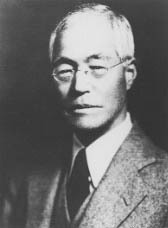Kan'ichi Asakawa facts for kids
Quick facts for kids
Kan'ichi Asakawa
|
|
|---|---|
| 朝河 貫一 | |
 |
|
| Born | December 20, 1873 Nihonmatsu, Fukushima, Japan
|
| Died | August 11, 1948 (aged 74) West Wardsboro, Vermont, U.S.
|
| Education | Waseda University Dartmouth College (BLitt) Yale University (PhD) |
| Occupation | Historian |
Kan'ichi Asakawa (朝河 貫一, Asakawa Kan'ichi, December 20, 1873 – August 11, 1948) was a Japanese historian, writer, and a strong supporter of peace. He was born in Japan but lived most of his life in the United States.
Contents
Early Life and Education
Kan'ichi Asakawa was born in Nihonmatsu, Japan, on December 20, 1873. He went to the Fukushima-ken Jinjo School in Fukushima Prefecture and later to Waseda University in Tokyo.
After his studies in Japan, he traveled to the United States. He attended Dartmouth College in Hanover, New Hampshire, and earned his Bachelor of Letters degree in 1899. He then continued his studies at Yale University. In 1902, he earned his Doctor of Philosophy (PhD) degree. His main research was about the history of feudalism in Japan.
Career as a Historian
Asakawa taught at Dartmouth College in 1902. He was also a professor at Waseda University in Japan from 1906 to 1907. He then returned to Yale University, first as an instructor from 1907 to 1910, and then as an assistant professor in 1910.
He did special research in Japan in 1906–07 and again from 1917–19. In 1937, he became a full professor at Yale University. This was a big achievement, as he was the first Japanese professor at a major American university. He taught history at Yale for 35 years.
In 1907, Asakawa also became the curator of the East Asian Collection at Yale's Sterling Memorial Library. This meant he was in charge of a large collection of books and materials from East Asia. He played a key role in starting the study of Asian cultures and history in the United States.
Working for Peace
After the Russo-Japanese War ended, Asakawa became worried about Japan's growing military power. He wanted to help create a good relationship between the United States and Japan.
In 1941, he tried to prevent war between the two countries. He attempted to convince President Roosevelt to send a personal message to the Japanese emperor. He hoped this would help avoid conflict.
Legacy and Remembrance
Today, Kan'ichi Asakawa is still remembered. Every summer, students from Dartmouth College who are studying in Japan visit his hometown of Nihonmatsu. They visit the high school where he studied and his grave. Some of his remains are buried in Nihonmatsu, and others are in the Grove Street Cemetery in New Haven, Connecticut.
In 2007, a special garden was created at Saybrook College at Yale University. This garden, called the Asakawa garden, was made to celebrate 100 years since he started teaching history at Yale.
Personal Life
Kan'ichi Asakawa married Miriam Dingwall on October 12, 1905. Miriam was born in 1879 in New Haven, Connecticut. She worked as a seamstress. They met when Asakawa was a student at Yale.
Their marriage was described as very happy. However, Miriam sadly passed away on February 4, 1913. She was buried in her family's graveyard in New Haven. Asakawa never remarried and did not have any children.
Selected Works
Asakawa wrote many books and articles. Some of his important works include:
- 1903 – The Early Institutional Life of Japan. This book was about the early history of Japan.
- 1905 – The Russo-Japanese Conflict: Its Causes and Issues. This book looked at the reasons behind the war between Russia and Japan.
- 1914 – The Origin of Feudal Land-Tenure in Japan
He also contributed to other publications, sharing his knowledge of Japanese history.

